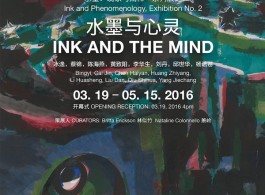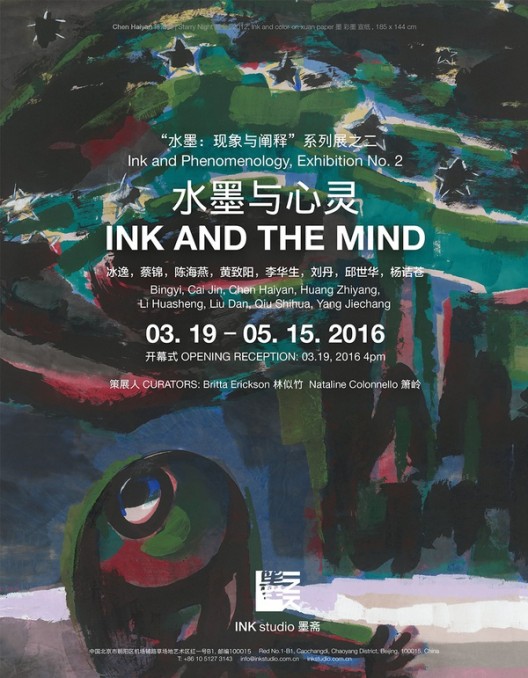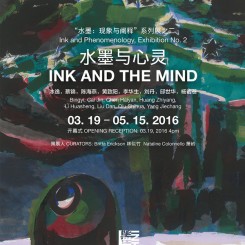INK AND PHENOMENOLOGY. EXHIBITION NO.2
Opening at INK studio on March 19, 2016, the group exhibition Ink and the Mind explores the myriad connections between ink painting and cognition, emotion, perception, memory, identity, moral judgment, desire, and imagination. The traditional Chinese understanding of the mind resists the Cartesian mind-body dualism that has defined much of modern Western thought and life; as is often noted, the character xin denotes both the physical organ of the heart and cognitive and affective functions. This non-dualistic conception of the mind is commensurate with the material specificities of the ink medium and with its intellectual and aesthetic values. Each deeply engaged with ink, the artists in this exhibition illuminate its relationship to the mind in powerful and diverse ways. Curated by Britta Erickson and Nataline Colonnello, this exhibition follows Ink and the Body of fall 2014 in the Ink and Phenomenology exhibition series, which explores ink painting in terms of its relationship with both the artist and the viewer.
Li Huasheng and Yang Jiechang approach the ink medium as a form of mental discipline and cultivation. After a tour in the United States as one of China’s foremost traditional landscapists in the late 1980’s, Li Huasheng turned away from representational painting and, over the next decade, developed the radical practice of hand-limning vast grids in a state of deep meditation. Applied with a pliant brush, these lines record with utmost sensitivity the momentary changes in his physical and mental being, becoming a metonym of the unfolding of life in time. In the Hundred Layers of Ink series, which debuted in the landmark exhibition Magiciens de la Terre (1989) at the Centre Pompidou, Yang Jiechang combines ink with durational performance, superimposing layers of ink on the same pieces of paper over weeks. The resultant black surfaces gain a surprising luminescence and sculptural presence, reflecting a Daoism-informed aesthetics of change and the Chan Buddhist notion of awakening through the mindful repetition of mundane actions.
The paintings of Qiu Shihua unfold the psychological and philosophical complexities of perception. Working in oil but with an ink painter’s sensitivity towards liquid diffusion and surface textures, he creates immersive fields of barely perceptible tonal nuances that invite and resist the recognition of forms, alternating between landscapes and mindscapes and turning observation into introspection. In the poetics of losing and finding oneself anew, the viewer experiences something of the artist’s life-long engagement with the Daoist philosophy of non-action. Despite its appeals to photorealism and close observation, Liu Dan’s rendition of rockery is abstracted from reality and more fundamentally an embodied resonance with the deep structure of the universe. He generates entire landscapes using rocks as “stem-cells,” bypassing the codified brushwork of the literati tradition while maintaining its core understanding of the self as essentially expressive and performative: that one defines one’s identity in continual dialog with history. Bingyi, too, offers a contemporary reinterpretation of literati ideals. Encompassing not only painting but also site-specific installation, performance, literary and musical composition, and filmmaking, her practice is unified as a poetic self-expressionism as in the literati’s Three Perfections. Rendered in hypnotic, near-microscopic brushwork, her Fairies—a vast catalog of imaginary life—give form and definition to her unbounded emotional energies.
Dreams, desire, and the unconscious take center stage in the works of Cai Jin, Chen Haiyan, and Huang Zhiyang. For two decades Cai Jin has memorialized a dying subtropical plant—known in Chinese by the sensuous name of “beauty plantain”—that she chanced upon and photographed during a visit to her hometown. Typically rendered in extreme magnification and in bright monochromatic colors, these paintings are both visceral and denatured, simultaneously evoking fertility and eroticism, death and decay. Chen Haiyan transforms the propagandistic medium of the socialist-realist woodblock print into a new vernacular language of self-expression by incorporating daxieyi ink painting. By visualizing and disseminating her dreams, she invites the viewer’s identification and reflection on the complex of conscious and unconscious, inner and collective lives in contemporary China. Huang Zhiyang’s Dreamscapes series explores different psychic and emotional states through color and the color symbolism of Buddhist spiritual and artistic traditions. Inextricably interwoven and constantly flirting with biomorphic imagery, the layers of pigments mirror our networked and embodied our consciousness and suggest its susceptibility to sensual temptation, denoted none other than se, the word for color.



